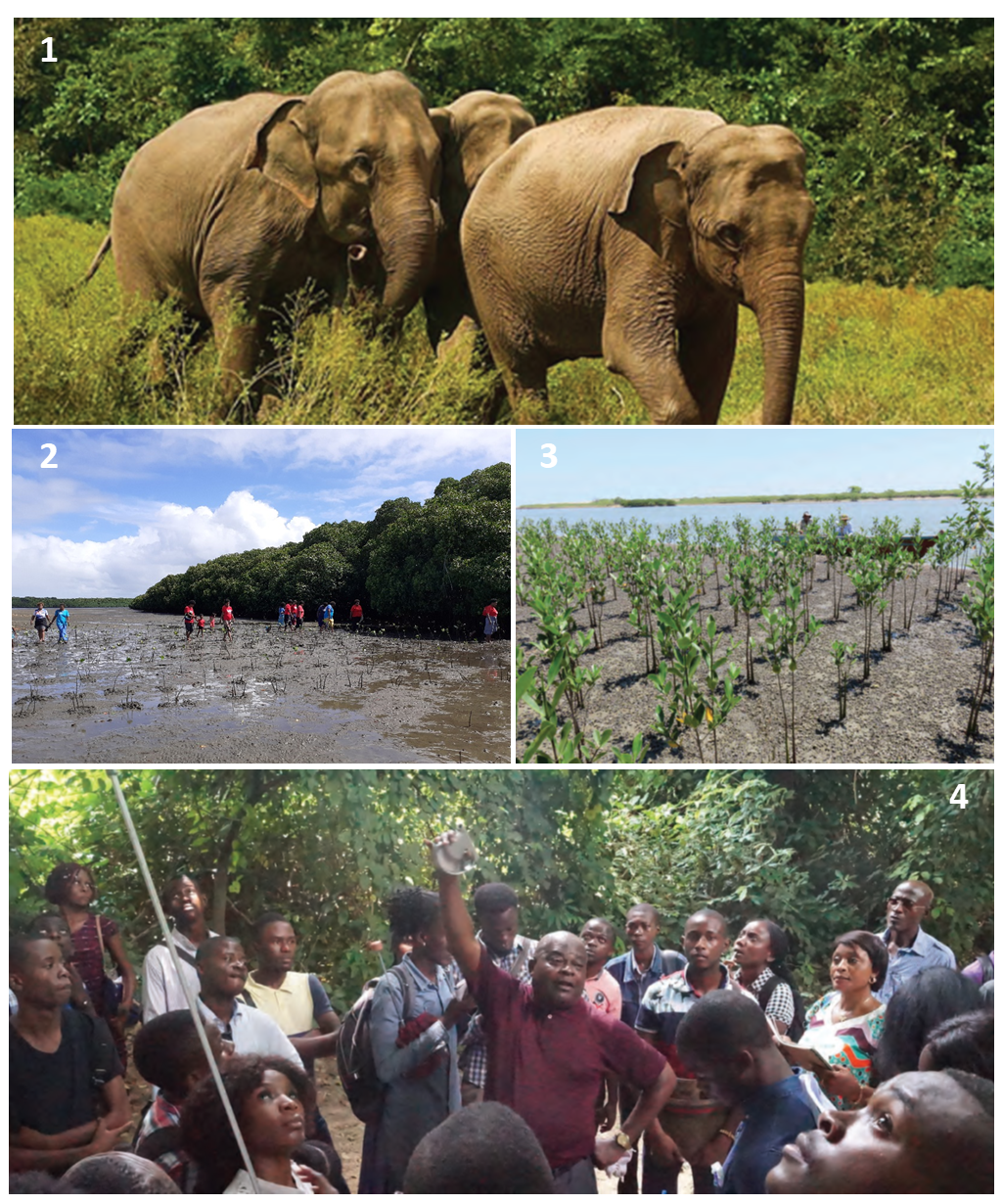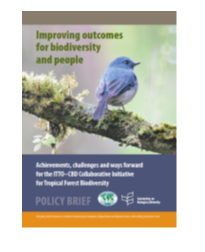 Ms Ida Rohaida
Ms Ida Rohaida
Improving outcomes for biodiversity and people: The ITTO–CBD Collaborative Initiative for Tropical Forest Biodiversity
The ITTO-CBD Collaborative Initiative
ITTO and the CBD launched in 2011 the ITTO–CBD Collaborative Initiative for Tropical Forest Biodiversity, with four objectives:
- 1) Enhance the local capacity for biodiversity conservation in production forests and for the rehabilitation of degraded and secondary forests.
- 2) Improve the conservation and management of protected areas, especially in association with buffering protected areas, and transboundary conservation.
- 3) Safeguard tropical forest biodiversity in forestry interventions, including in REDD+- related projects.
- 4) Improve the welfare of local communities and indigenous groups through biodiversity conservation and the sustainable use of natural resources.
- Supported by donors and in close collaboration with partners in ITTO producer member countries, the Collaborative Initiative identifies, develops and implements projects to achieve these objectives.
Extraordinary results
Between its creation in 2011 and the latter part of 2020, the Collaborative Initiative encompassed 16 projects (see Table below). These projects were conducted in 23 tropical countries, all of which have experienced declines in forest area and losses of biodiversity and have large numbers of forest-dependent people.
At USD 13 million, the total budget of the 16 projects was modest, but a technical review found that they achieved

The projects contributed to the main global processes with forest implications:
- Aichi Biodiversity Targets
- Sustainable Development Goals #15 on Forests
- Global Forest Goals
- International Tropical Timber Agreement
Of the 16 projects:
Five were in transboundary areas (e.g. the Emerald Triangle area shared by Cambodia, the Lao People’s Democratic Republic and Thailand).
Four worked to improve forest management in various types of reserve (e.g. a biosphere reserve in Benin).
Five improved management in production forests (e.g. mangrove forests in Fiji).
Two improved education on biodiversity conservation and sustainable forest management designed for forest managers in countries in sub-Saharan Africa and the upper Amazon Basin.
Eleven contributed to the livelihoods of communities living in or near protected areas (e.g. in the Tacaná Volcano area of influence on the border between Guatemala and Mexico).
Six engaged local communities in sustainable forest management (e.g. buffer-zone management near the Pulong Tau National Park, Malaysia).
Specific achievements
(Photo composition)

Specific achievements included:
- Enabling previously difficult transboundary cooperation on the management of the Emerald Triangle between Cambodia and Thailand
Photo #1: Asian elephants are on the move near the Preah Vihear Protected Forest in Cambodia, under ITTO Project PD577/10 - Photo: Phnom Tamao Wildlife Rescue Centre/ Forestry Authority/Wildlife Alliance [Learn more about ITTOProject PD577/10...]
- Restoring 130 ha of mangroves in Fiji
Photo #2: The Nasilai women’s group planted 5000 mangrove propagules along the foreshores of their village in Fiji, under ITTO project PD 696/13. Photo: Aporosa Ramulo Livani/Ministry of Forestry [Learn more about ITTO Project PD 696/13…]
- Increasing the size of a mangrove protected area in Peru by more than 700 000 ha
Photo #3: Making a stand: These mangrove seedlings were planted as part of restoration efforts in the Estero La Chepa–Corrales Mangrove Conservation Area under ITTO Project PD601/11. Source: ITTO Tropical Forest Update 26/3, 2017, p.16. Photo: ITTO–MDA project [Learn more about ITTO Project PD601/11...]
- Providing more than 400 foresters and technicians in Central Africa with forestry education
Photo # 4: Professor Mbeté demonstrates forest-measuring equipment to a group of students under ITTO project PD 456/07. Photo: Mamonékéné [Learn more about ITTO Project PD 456/07…]
Lessons learned
The important lessons learned in the implementation of the Collaborative Initiative’s 16 projects, outlined below, can readily be applied to future projects.
When working with Communities…
- Indigenous and other local communities must derive benefits from such projects, and traditional land rights and practices must be enabled to continue;
- Clear indicators should be established to measure the effectiveness of such projects in addressing long-term
- livelihoods, sustainability and biodiversity conservation;
- The existing capacities of such stakeholders should be assessed before the development of training programmes and convening of workshops;
- The establishment of community forests is a promising land management approach in the buffer zones of protected areas. Such forests should be established in suitable locations to increase their chances of success.
When working with governments...
- Include representatives of all levels of government in project steering committees to assure Local government authorities at all levels (e.g. municipal, district and provincial) should be involved in projects as much as possible;
- Political support at high levels of government in participant countries is essential for the success of transboundary conservation and restoration projects and for sustaining outcomes over time.
- The membership of steering committees for transboundary conservation and restoration projects should include all relevant agencies at the highest possible level of government.
Renewing the collaborative initiative
In 2021, the CBD renewed its strategic plan for sustaining and conserving global biodiversity in its post-2020 biodiversity framework and ITTO adopted its new Strategic Action Plan 2022–2026. In February 2021, ITTO and the CBD formally extended their joint work to 2025 in a new memorandum of understanding. The Collaborative initiative will be revised in light of this with the aim of continuing its long-term commitment to enhancing biodiversity conservation in tropical forests with the direct participation of local stakeholders.
The next phase of the initiative, likely to begin in 2023, will comprise part of efforts to achieve the forest-related targets of the Post-2020 Global Biodiversity Framework.

Related ITTO-CBD Publications
 Policy brief: Improving outcomes for biodiversity and people, Policy Brief, International Tropical Timber Organization (ITTO) and Convention on Biological Diversity, March 2022 [PDF, 1.16 Mb]
Policy brief: Improving outcomes for biodiversity and people, Policy Brief, International Tropical Timber Organization (ITTO) and Convention on Biological Diversity, March 2022 [PDF, 1.16 Mb]- News: Joint work between ITTO and Convention on Biological Diversity lauded, ITTO, 3 march 2022, ITTO News, 3 march 2022
- ITTO Twitter account: sustainableforestry @itto_sfm
Related SDGs
The 16 projects conducted under the Collaborative Initiative, 2011–2020
| Project # | Short title | Country | Relevant Collaborative Initiative objectives |
|---|---|---|---|
| 1 | Capacity-building for sustainable forest management and conservation in the Congo Basin | Cameroon, Central African Republic, the Congo, Democratic Republic of the Congo, Gabon | 1 |
| 2 | Management of the Emerald Triangle Protected Forests Complex | Cambodia, Thailand | 2,4 |
| 3 | Mangrove ecosystem conservation in the northwestern Peru biosphere reserve | Peru | 1,4 |
| 4 | Transboundary biodiversity conservation in the Betung Kerihun National Park | Indonesia, Malaysia | 1,2,3,4 |
| 5 | Buffer zone management of the Pulong Tau National Park with local communities | Malaysia | 2,4 |
| 6 | Integrated natural resource management in the Tacaná Volcano range | Guatemala, Mexico | 1,2,4 |
| 7 | The conservation of selected high-value indigenous species in Sumatra | Indonesia | 1 |
| 8 | The rehabilitation and sustainable forest management of sacred forests at Ramsar sites 1017 and 1018 | Benin | 3,4 |
| 9 | Capacity-building in the Congo Basin for sustainable forest management and use of satellite imagery | Angola, Cameroon, Central African Republic, Chad, the Congo, Democratic Republic of the Congo, Equatorial Guinea, Gabon, Rwanda | 2 |
| 10 | Capacity building of Amazon Cooperation Treaty Organization member countries in managing Amazonian forests | Bolivia, Brazil, Colombia, Ecuador, Guyana, Peru, Suriname, Venezuela | 1,3 |
| 11 | Transboundary biodiversity conservation in the Tanintharyi Range | Myanmar | 2,4 |
| 12 | Community-based restoration and sustainable forest management in mangrove forests of the Rewa Delta | Fiji | 1,3,4 |
| 13 | Capacity-building for sustainable forest management in tropical dry forests on the north coast of Peru | Peru | 1,4 |
| 14 | Restoration and sustainable forest management of sacred forests at Ramsar sites 1017 and 1018a | Benin | 3 |
| 15 | Developing a forest landscape restoration programme based on ITTO guidelines | Guatemala | 1 |
| 16 | Restoration of Cibodas Biosphere Reserve involving local stakeholders | Indonesia | 1,4 |
